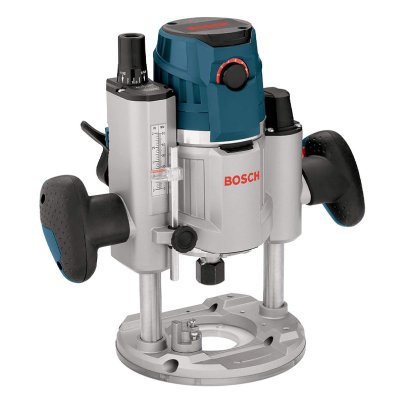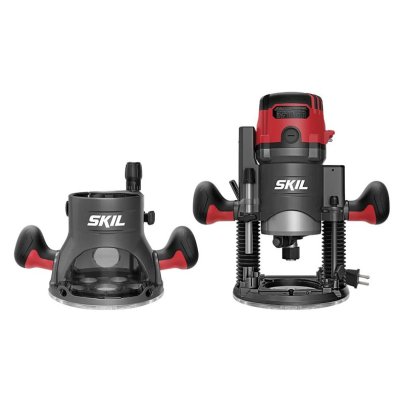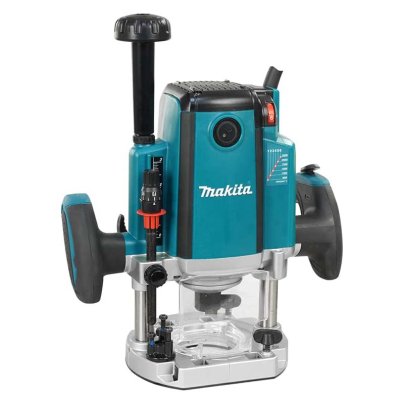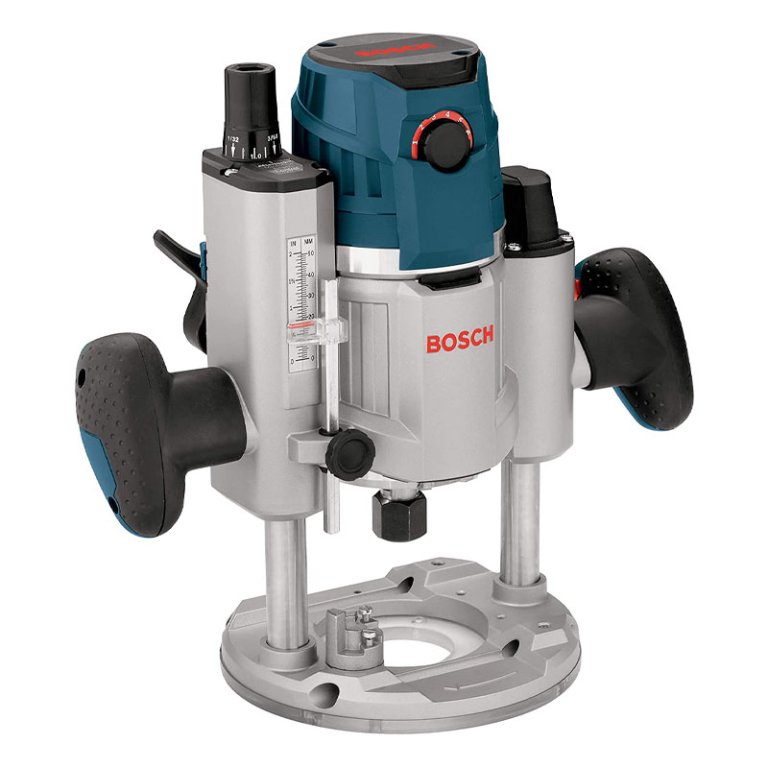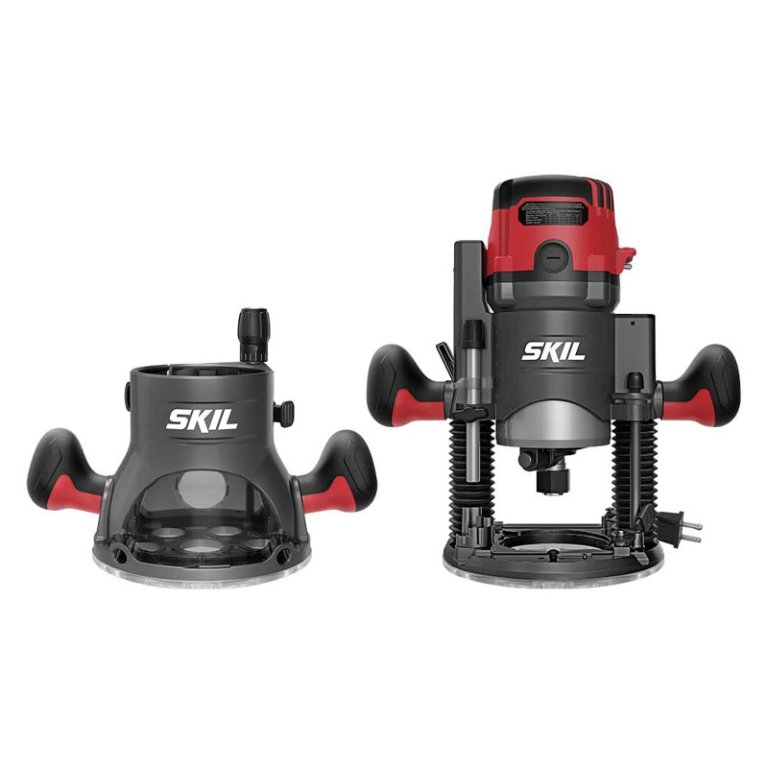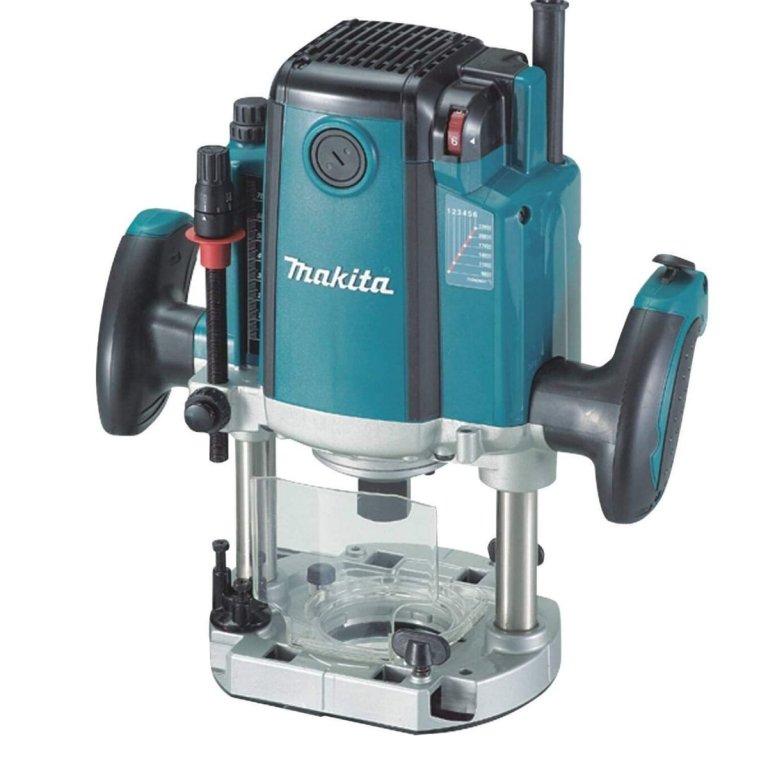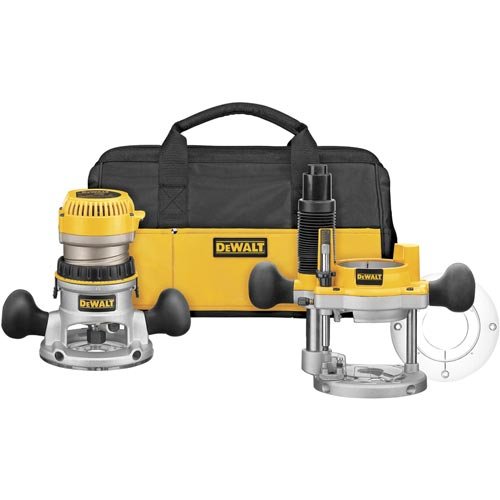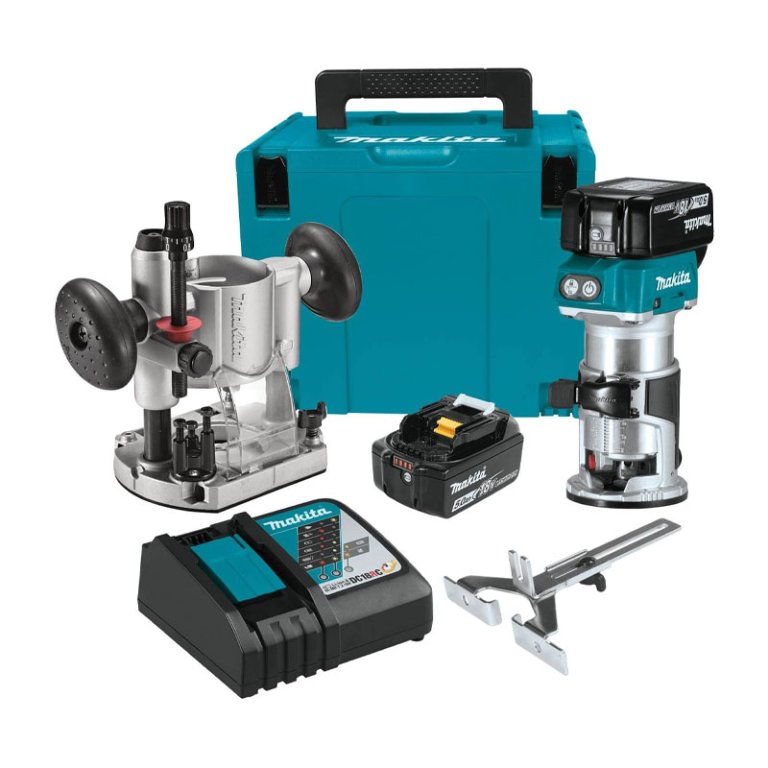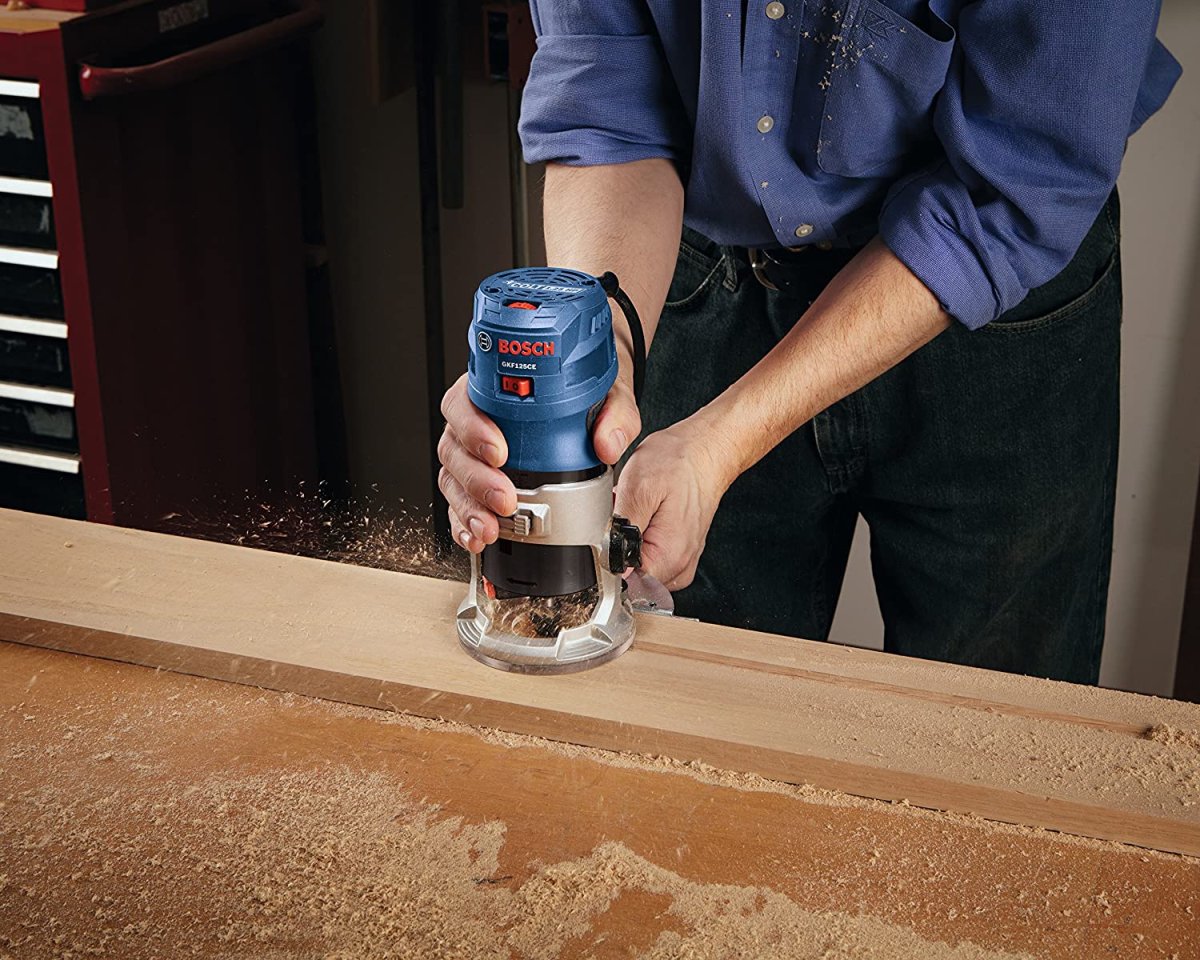
We may earn revenue from the products available on this page and participate in affiliate programs. Learn More ›
Whether it’s rounding off the edge of a shelf board or creating a mortise in the center of a piece of hardwood, woodworkers often reach for a plunge router power tool to get many kinds of carpentry jobs done. This versatile, high-speed power tool makes boring accurate patterns and creating tight-fitting joinery a faster process than hand tools can manage.
A plunge router tool is ideal for building bookshelves, cabinetmaking, and creating mortise-and-tenon joinery, but for those in the market for one, it’s important to purchase a plunge router that balances skill level, budget, and the types of planned projects. Our favorite model is the Bosch 120-Volt 2.3-HP Electronic Plunge Base Router thanks to its robust motor, impressive speed range, and adjustable collet sizes.
This guide explains the important fundamentals and features of these tools and offers some of the best plunge router options to add to a carpentry kit of essential tools to work wood.
- BEST OVERALL: Bosch 120-Volt 2.3 HP Electronic Plunge Base Router
↓ Jump to Review - BEST BANG FOR THE BUCK: Skil 14-Amp Combo Plunge and Fixed Base Router
↓ Jump to Review - UPGRADE PICK: Makita RP2301FC 3¼ HP Plunge Router
↓ Jump to Review - BEST FOR BEGINNERS: DeWalt Fixed/Plunge Base Router Kit
↓ Jump to Review - BEST FOR SMALL PROJECTS: Bosch GKF125CEPK Colt Palm Router
↓ Jump to Review - BEST CORDLESS: Makita XTR01T7 18V LXT Brushless Cordless Router Kit
↓ Jump to Review

How We Chose the Best Plunge Router
When it comes to woodworking and renovations, wood routers (whether fixed or plunge) can be a vital part of the project. Knowing that, it was important that we put together a list consisting of only the best plunge routers on the market. Here’s how we did it:
First, we stood on years of woodworking and construction experience to not only choose trusted brands but also pick out the features we felt are most important in a plunge router. Next, we performed extensive product research to compare the top models from each brand, eliminating ones we felt didn’t offer enough capability. Finally, we compared the models’ prices to ensure that they offered the type of value a DIYer or pro would expect from a tool. The plunge routers that remained were given awards, and our list was ready.
Our Top Picks
From beginner models to professional gear, the plunge routers and other wood shop tools on this list are among the best in class. Check out their features, capabilities, and pros and cons so you can choose the best tool for your shop.
Best Overall
Bosch 120-Volt 2.3 HP Electronic Plunge Base Router
What We Like
- Impressive speed range from 10,000 to 25,000 RPM
- Soft-start technology for added safety
- Adjustable collet sizes for a variety of bits
- Heavy-duty 15-amp motor
What We Don’t Like
- Could be a bit much for new woodworkers
Product Specs
- Max speed: 25,000 revolutions per minute (RPM)
- Style: Dedicated
- Size: ¼ or ½ inch
This Bosch plunge wood router (MRP23EVS) is a true workhorse, capable of tackling any job. It boasts 10,000 to 25,000 RPM of run speed, thanks to its 2.3-horsepower (hp) 15-amp electric motor. It’s not all brawn, though, thanks to features like a handle-mounted trigger, soft-start tech, electronic feedback control, and the ability to make micro adjustments with consistent results. It also offers the flexibility of using both ¼-inch and ½-inch collet chucks, as well as a built-in LED light for visibility.
The only drawback is this large model may be too much router for newbies, particularly those who are attempting intricate or delicate work like carving patterns or routing thin pieces of wood.
Get the Bosch 120-volt plunge router at Amazon, Lowe’s, The Home Depot, or Grainger.
Best Bang For The Buck
Skil 14-Amp Combo Plunge and Fixed Base Router
What We Like
- Digital display for precise speed and control
- Electronic feedback to modulate output for different wood densities
- Plunge and fixed bases included
What We Don’t Like
- Edge guide is a bit cheap
Product Specs
- Max speed: 25,000 RPM
- Style: Swappable
- Size: ¼ inch and ½ inch
This Skil 14-amp plunge and fixed base router kit comes ready to go with both fixed and plunge router bases for optimal flexibility. Though a value pick, it doesn’t fall short on capability, including such attractive features as an LCD screen for speed control that also adjusts speed settings according to the collet size installed (¼-inch or ½-inch collet).
The Skil router for wood has a top speed of 25,000 RPM, allowing it to tackle all sorts of wood species. It also has soft-start tech for safety and electronic feedback technology, as well as an edge guide for controlled routing. While the edge guide isn’t terribly robust, it’s fine for the price point.
Get the Skil plunge router at Amazon, Lowe’s, or JB Tools.
Upgrade Pick
Makita RP2301FC 3¼ HP Plunge Router
What We Like
- Micro and macro adjustments allows quick depth changes
- Grip-mounted lock-on trigger for continuous use and limited vibration
- Soft-start tech for safely starting the large bits
- Electric brake and LEDs for added safety
What We Don’t Like
- Might be too expensive for some DIYers
Product Specs
- Max speed: 22,000 RPM
- Style: Dedicated
- Size: ¼ and ½ inch
For DIYers and pros shopping for a router with some serious power, the Makita RP2301FC 3¼ hp plunge router ought to fill the bill for many, thanks to its 15-amp electric motor that produces from 9,000 up to 22,000 RPM. Plus, several user-friendly features really help get the job done, like swappable ¼-inch and ½-inch collets, an ergonomic two-finger switch, a lock-on trigger, and twin LED lights for illuminating the project.
The Makita is a dedicated plunge-router, which allows for the smoothest possible plunging action. It offers accurate micro-adjustments (along with macro adjustments for quickly getting to size). It features a grip-mounted trigger and soft-start technology, the combination of which provides secure starts, while the electric brake quickly brings the spindle to a rest after releasing the trigger.
These types of features do drive up the cost, of course, and this router doesn’t have the flexibility of a router kit with a swappable plunge base for router tasks.
Get the Makita RP2301FC plunge router at Amazon, The Home Depot, Walmart, or Grainger.
Best For Beginners
DeWalt Fixed/Plunge Base Router Kit
What We Like
- Swappable bases for improved versatility
- Micro adjustments to easily nail the proper depth
- ¼-inch and ½-inch collets offer finishing options
What We Don’t Like
- Soft carrying bag offers no protection
Product Specs
- Max speed: 24,000 RPM
- Style: Swappable
- Size: ¼ and ½ inch
This DeWalt kit covers nearly all bases—a boon to newer woodworkers who might not have the budget to purchase several routers. It comes with both plunge and fixed bases (a nice feature that makes this model suitable for a router table), plus a reasonable price considering its professional pedigree.
This model’s speed adjusts between 8,000 and 24,000 RPM, with its 12-amp motor getting the job done on many types of woods. It also features micro-adjustability, which makes dialing in the perfect depth fast and accurate. Collet sizes include both ¼-inch and ½-inch models, and the kit comes with a wrench, dust adapter, and soft carrying case (a point of contention for some DIYers used to DeWalt’s legendary hard case). We did manage to find the durable kit box included when purchased at The Home Depot, though. See the link just below.
Get the DeWalt plunge router kit at Amazon, Lowe’s, or The Home Depot.
Best For Small Projects
Bosch GKF125CEPK Colt Palm Router
What We Like
- Very high maximum speed of 35,000 RPM
- Compact size makes it easier to control
- Swappable bases add versatility and user-friendliness
What We Don’t Like
- Huge amount of power may be tricky for first-time users
Product Specs
- Max speed: 35,000 RPM
- Style: Palm with swappable bases
- Size: ¼ inch
Another high-quality option from Bosch, this smaller palm-style router is an excellent choice for light-duty work and doubles as a laminate trimmer. This kit comes with a plunge base, as well as a fixed base, edge guide, and ¼-inch collet chuck.
Despite its small size, this hand router is very fast with a maximum top speed of 35,000 RPM. The plunge base features easy-to-use depth adjustments and operates very smoothly. Thanks to its size, it’s relatively easy to control. Speed is variable, but without a soft-start feature built in, a large bit in its collet can cause the Bosch Colt to jump a bit when starting.
Get the Bosch Colt Palm plunge router at Amazon, Lowe’s, The Home Depot, or Grainger.
Best Cordless
Makita XTR01T7 18V LXT Brushless Cordless Router Kit
What We Like
- Long-lasting 5.0 amp-hour battery
- Great speed for a cordless option
- Electronic motor control for smooth, consistent results
- Cordless design allows for maximum portability
What We Don’t Like
- Less versatile than comparable options
Product Specs
- Max speed: 30,000 RPM
- Style: Swappable
- Size: ¼ inch
Swapping to a cordless plunge router might be the move of the future, as DIYers may enjoy not having to worry about tripping over a cord. For those on board, the Makita XTR01T7 18V LXT brushless cordless router kit might be of interest. This kit features a cordless router with both fixed and plunge bases, as well as a 5.0-amp-hour battery, charger, edge guide, and hard carrying case.
This cordless router features a top speed of 30,000 RPM, giving it more speed than most corded models. It features an electronically controlled brushless motor that will modulate output based on material density for smooth, consistent results. The bases have micro and macro adjustments for dialing in the correct depth, and the on-off button locks to prevent accidental starts. Dual LED lights make seeing the workpiece convenient, as well. As far as inconvenience goes, the only thing worth mentioning is this model only accepts ¼-inch router bits.
Get the Makita XTR01T7 plunge router at Amazon or The Home Depot.
Jump to Our Top Picks
What to Consider When Choosing a Plunge Router
Routers are rotary tools that spin specialty bits at very high speeds. The user tightens a bit into the collet and either flips a switch or presses a trigger to turn the machine on and start carving.
We spoke with Jay Sanders, general contractor and owner of Maryland Contractors in Baltimore, Maryland, who shared his thoughts on these tools when used in a professional setting. He says that plunge routers are unmatched when it comes to “making stopped cuts, mortises, inlays, or cutting grooves within the workpiece.”
While a fixed router’s bit is always exposed (but can be adjusted for height), plunge routers have suspended bases that allow the user to lower the bit into the workpiece while still being under control—essential for routing in the middle of a board.
Sanders also points out that a critical aspect of a plunge router for shoppers to consider is “precise cutting depths that you can easily control.” He suggests looking for a depth stop accuracy to within 1/64 of an inch.
Woodworking relies on a plunge router to not only cut dados, grooves, and mortises in the center of a board but also to mill profiles on the side of a board and flush-trim a piece of laminate to size. Here are a few things to consider when looking for the best plunge router.
Style
Plunge router styles include standard, palm, and laminate trimmer. Standard routers are typically larger, powerful yet heavy models that can receive both ¼-inch and ½-inch style bits. They’re commonly used for routing designs, grooves, or dados in the field of a piece of wood, but they’re also capable of routing the edge of a board.
Laminate- and palm-style routers (designed to be held in the palm of a hand as opposed to using handles) are smaller, lighter, and less powerful. They’re suitable for use with smaller router bits that don’t require the maximum speed a larger model can provide. They’re handy for flush-trimming laminate and thinner (½ inch thick or less) wood as well.
Size
Router size refers not to the size of the machine but the diameter of the collet, which is the mechanism that holds the router bits in place. Because of the high speeds involved and the type of work routers do, collets must be machined to hold the bit securely and perfectly centered.
The two standard woodworking collet sizes are ¼ inch and ½ inch. Most routers are compatible with both sizes, allowing the users to swap out the collet with an included replacement—a real value.
However, some palm-style routers or laminate trimmers don’t have an interchangeable collet and use ¼-inch collets only; for the most part, these are lighter-duty models with less powerful motors that require a smaller bit to function properly. But there are high-quality models that are simply compact and designed for these smaller bits.
Speed
Routers of all sorts come with different speeds and speed settings. Low speeds (used for extremely hard woods or with large bits) tend to be in the 8,000- to 10,000-RPM range. On the other end of the spectrum, the average top speed for the best router is closer to 22,000 RPM—sufficient for all wood-routing needs. Anything higher than that is considered extremely fast and would be primarily used for projects like trimming laminate on a countertop.
Speed adjustment is usually determined by a dial, knob, or digital gauge. Users can choose their desired speed by twisting the knob or dial to the correct setting, or by pushing the buttons to adjust the digital readout’s setting.
Soft Start
Soft-start technology allows a power tool to get up to speed gradually—a potentially important safety feature on a router. Routers lacking this feature tend to twist or jump when first turned on. If the tool isn’t held securely, this sudden jolt can cause the router to spin out of the user’s hand, potentially causing serious injury.
This jolt upon start-up can be particularly pronounced with a larger router bit chocked in the collet. Soft-start technology ramps up the speed slowly, allowing it to minimize the initial torque, decreasing the likelihood of a jump or twist when the switch or trigger is activated. This can be a much safer option for a beginner unaccustomed to routers and their running speeds.
Router Table Compatibility
For very detailed and consistent work, some users install a router in a router table, which provides a flat service for manipulating the wood across the bit, as opposed to the users holding the router in their hands.
Plunge routers without swappable bases don’t typically lend themselves well to universal router tables. The main issue is height adjustment, as a plunge router will naturally hang at the top of its travel, away from the tabletop—which makes it difficult to adjust the height of the bit and maintain consistent results.
As an alternative to a dedicated plunge router, consider purchasing a kit with swappable bases. These models use both a base that plunges and a fixed base, offering the flexibility of two routers.
Spindle Lock
To safely work with a plunge router, the collet must be finely machined and tightly grip the router bit. As a result, it can be challenging to loosen. To make it easier to swap out bits, look for a router with a spindle lock.
Spindle locks (typically buttons on the side of the router) snap into a groove in the router’s spindle to keep it from turning. The user can press the spindle lock and place a wrench around the collet to loosen or tighten it. When done with the task at hand, simply release the button and the spindle will spin freely again. All modern routers offer some type of spindle lock.
Pro Tip: Spindle locks are not safety features. Whenever a router bit change is necessary, unplug it from its power source before considering it safe to handle.
Electronic Feedback Circuitry
For the best plunge router technology, look for a model with electronic feedback circuitry. This technology continually monitors the workload the router is experiencing, making necessary adjustments to maintain the proper speed.
This is important because bits operate differently at different speeds. As a rule, the higher the rate, the smoother the cut. If the load increases—say, through a denser section of wood—a router with electronic feedback circuitry will compensate and attempt to maintain the proper speed. Electronic feedback circuitry provides a more consistent result and a more pleasant user experience.
Swappable Kits vs. Dedicated Plunge Routers
There are two types of plunge routers available: Kits with swappable bases and those with dedicated plunge routers. Kits with swappable bases are excellent for DIYers or woodworkers who want the best of both worlds, as these kits come with both fixed bases and plunge bases. The user simply unlocks the router body from the base and fits the new base in its place.
Dedicated plunge routers don’t have removable bases. These models are forever-fitted with plunging bases. The benefit of a dedicated model is that the plunging action tends to be smoother than a kit model.
FAQs
There’s a lot of information available on plunge routers, and it can seem overwhelming to try to take it all in at once. Here are a few of the most commonly asked questions that come up about these tools. If you have a question not resolved below, call your model’s manufacturer for answers.
Plunge routers can cut dados, mortises, or even patterns in the middle of a board, as well as route edges and cut tenons in the ends of boards.
A plunge router may require a custom table or retrofit if it doesn’t come off of its base. Fixed-base routers are better suited for router tables.
A plunge router can certainly do everything a fixed router can, just potentially less accurately. Fixed routers have few moving parts, making it easier to precisely dial them in.
This depends on the model, but the deepest plunging router on our list plunges 2¾ inches. Some lighter-duty models will have less travel.
Make sure to keep the lock and depth controls clean and lubricated. WD-40, PTFE spray, or a rust prevention spray will help keep the moving parts in top condition. Users will also want to clear away any wood chips or sawdust that can get caught between the base and the motor.
It’s certainly doable, but you will not achieve as accurate a result as you would with a fixed-based router. Plunge routers are best for projects that require working from above, whereas a fixed-base model will shine when doing edgework.
